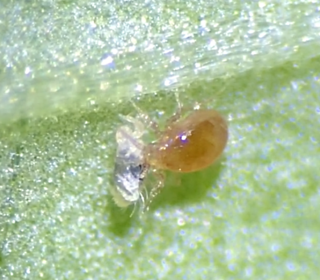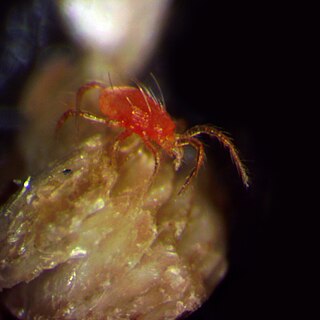
The Phytoseiidae are a family of mites which feed on thrips and other mite species. They are often used as a biological control agent for managing mite pests. Because of their usefulness as biological control agents, interest in Phytoseiidae has steadily increased over the past century. Public awareness of the biological control potential of invertebrates has been growing, though mainly in the US and Europe. In 1950, there were 34 known species. Today, there are 2,731 documented species organized in 90 genera and three subfamilies.

Amblyseius is a large genus of predatory mites belonging to the family Phytoseiidae. Many members of this genus feed on other mites such as red spider mites, and also on thrips. Several species are popular as biological control agents to control these pests.
The Amblyseiinae are a subfamily of mites in the Phytoseiidae family.
Typhlodrominae is a subfamily of mites in the Phytoseiidae family.
Iphiseiodes is a genus of mites in the Phytoseiidae family.
Paraamblyseius is a genus of mites in the Phytoseiidae family.
Paraphytoseius is a genus of mites in the Phytoseiidae family.
Phyllodromus is a genus of mites in the Phytoseiidae family.

Phytoseiulus is a genus of mites in the Phytoseiidae family. A predatory mite, this is the mite predator most frequently used to control two-spotted spider mites in greenhouses and outdoor crops grown in mild environments. This mite was accidentally introduced into Germany from Chile in 1958; it was subsequently shipped to other parts of the world, including California and Florida, from Germany. A Phytoseiulus mite can consume up to seven adult spider mites or several dozen of their eggs in a day. Adult females are reddish, pear-shaped, about 0.5 mm (0.020 in) long, and active at room temperature. Immatures and males are smaller and lighter in color. Eggs are oblong. About 80% are females. At optimum temperatures, Phytoseiidae can develop from egg to adult in seven days and live up to a month. A well-fed female lays about 50 eggs in her lifetime.
Proprioseiopsis is a genus of mites in the family Phytoseiidae.
Proprioseius is a genus of mites in the Phytoseiidae family.
Ricoseius is a genus of mites in the Phytoseiidae family.
Typhlodromalus is a genus of mites in the Phytoseiidae family.
Galendromimus is a genus of mites in the Phytoseiidae family.
Galendromus is a genus of mites in the Phytoseiidae family.
Leonseius is a genus of mites in the Phytoseiidae family.
Metaseiulus is a genus of mites in the Phytoseiidae family.
Typhloseiopsis is a genus of mites in the Phytoseiidae family.
Euseius concordis is a species of mite in the family Phytoseiidae.
Phyllodromus trisetatus is a species of mite in the family Phytoseiidae.


